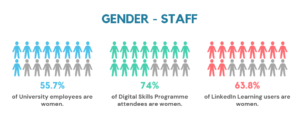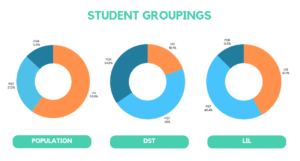Who attends digital skills training – and why does it matter?
The Digital Skills Programme is a selection of training courses available free of charge for all University of Edinburgh students and staff. It includes in-person courses and webinars across a range of topics, and runs throughout the academic year. The number of course attendees has grown steadily over the past few years – in 2024 we delivered 604 training courses to 5210 attendees. This represents a growth of around 42% compared with 2023. With the steady increase in attendance, we wanted to better understand our audiences and how we could continue to support them.
With the help of our Data and Equality Officer, we analysed anonymised attendance data across a number of demographic characteristics, and compared them with overall University population percentages to identify significant differences between training attendance and the overall population. For a well-rounded picture, we also included data from LinkedIn Learning usage statistics. Our team manages the LinkedIn Learning service – a video-based, asynchronous learning platform with thousands of high-quality courses on technical, business and creative skills, delivered by industry experts. All University students and staff have free access to LinkedIn Learning. It has around 2000 monthly users from across the University, viewing around 1000 hours of content.
Below is a summary of our key findings among staff and student populations:

Gender breakdown of staff engagement compared with University population.
Staff
- Women were much more likely to engage with any type of digital skills development than men.
- Professional Services colleagues were more likely to engage with digital skills development than academic colleagues.
- College based staff were more likely to attend Digital Skills Programme courses, whereas those based in Professional Services Groups showed preference towards LinkedIn Learning.
- Staff under 24 years of age and over 55 years of age were less likely to engage with any form of digital skills development than staff aged between 25-55.
Students

Proportions of postgraduate and undergraduate student populations engaging with digital skills development, compared with University populations.
- Women were more likely to attend Digital Skills Programme courses, while men were more likely to engage with LinkedIn Learning.
- Postgraduate students were much more likely to attend Digital Skills Programme courses, while Undergraduates showed a preference towards LinkedIn Learning.
- Students from the College of Arts, Humanities and Social Sciences, and students from the College of Medicine and Veterinary Medicine were more likely to attend Digital Skills Programme courses, while students from the College of Science and Engineering were more likely to engage with LinkedIn Learning.
- Students aged 26 and over were much more likely to engage with any type of digital skills development than younger students. Those aged <17-21 showed preference towards LinkedIn Learning.
- The majority of students engaging with digital skills development were international students.
There are a number of potential explanations as to why these variations may occur. In her article ‘How do our students learn? Demographics in digital skills training programmes’ our Data and Equality Officer, Katie, writes that these explanations might include digital shock and digital border crossing – phenomena experienced by international students, which may result in less familiarity with technologies used in UK Universities, prompting international students to seek additional training. Moreover, the MHFH (male hubris, female humility) phenomenon might help explain the prevalence of women engaging with digital skills development opportunities. Practicalities might also be at play – for example, time constraints, location of training courses, learning preferences, and wider variety of learning on specialist software available on LinkedIn Learning.
Why is this important?
Ultimately, we want to help every student and member of staff reach their potential. Different audience groups show a clear preference towards different types of learning – with this understanding, we are able to tailor and market our offering more effectively. On the one hand, we can offer more of the same. For example, we know that younger students prefer to engage with LinkedIn Learning. This might mean that our Welcome Week promotions focus heavily on the use of LinkedIn Learning. We also know that international students are much more likely to engage with digital skills development, which might prompt us to specifically advertise our offering to international students through selected communications channels.
On the other hand, we can use this understanding to identify potential digital skills gaps among our audiences. Addressing digital skills gaps helps widen career opportunities and improves the inclusivity and diversity of our organisation. Is there a reason we don’t see much engagement from staff over the age of 55? How could we encourage more men to develop their digital skills? Why are academic colleagues less likely to engage with digital skills development? These questions encourage us to think about our offering from a different perspective. It may be that our current offering is not suited to the needs of these audience groups, or it could be that they are not aware of the learning opportunities we provide. In any case, understanding who uses our services – and who doesn’t – helps us contextualise our offering for different audience groups, and address any digital skills gaps.
Links
Katie Grieve – How do our students learn? Demographics in digital skills training programmes (University of Edinburgh login required)


